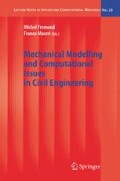Abstract
An elasto-plasticity model with coupled hardening variables of strain type is presented. In the theoretical framework of generalized associativity, the formulation of this model is based on the introduction of two hardening variables with a coupled evolution. Even if the corresponding hardening rules are linear, the stress-strain hardening evolution is non-linear. The numerical implementation by a standard return mapping algorithm is discussed and some numerical simulations of cyclic behaviour in the univariate case are presented.
Access this chapter
Tax calculation will be finalised at checkout
Purchases are for personal use only
Preview
Unable to display preview. Download preview PDF.
References
Zarka J., Casier J. (1979) Elastic plastic response of a structure to cyclic loadings: practical rules. Mechanics Today, 6, Ed. Nemat-Nasser, Pergamon Press
Khabou M.L., Castex L., Inglebert G. (1990) Effect of material behaviour law on the theoretical shot peening. Eur. J. Mech., A/Solids, 9, 6, 537–549.
Halphen B., Nguyen Q.S., (1975) Sur les matériaux standards généralisés. J. de Mécanique, 14, 1, 39–63
Inglebert G., Vial D., Point N. (1999) Modèle micromécanique à quatre paramètres pour le comportement élastoplastique. Groupe pour l’Avancement de la Mécanique Industrielle, 52, march 1999
Vial D., Point N. (2000) A Plasticity Model and Hysteresis Cycles. Colloquium Lagrangianum, 6–9 décembre 2000, Taormina, Italy.
Simo J.C., Hughes T.J.R. (1986), Elastoplasticity and viscoplasticity. Computational aspects.
J. Lemaitre, J.L. Chaboche (1990), Mechanics of Solid Materials, Cambridge University Press, Cambridge, UK.
Armstrong P.J., Frederick C.O. (1966), A mathematical representation of the multiaxial Baushinger effect. CEGB Report, RD/B/N731, Berkeley Nuclear Laboratories.
Author information
Authors and Affiliations
Editor information
Editors and Affiliations
Rights and permissions
Copyright information
© 2005 Springer-Verlag Berlin Heidelberg
About this chapter
Cite this chapter
Point, N., Erlicher, S. (2005). A Non-linear Hardening Model Based on Two Coupled Internal Hardening Variables: Formulation and Implementation. In: Frémond, M., Maceri, F. (eds) Mechanical Modelling and Computational Issues in Civil Engineering. Lecture Notes in Applied and Computational Mechanics, vol 23. Springer, Berlin, Heidelberg. https://doi.org/10.1007/3-540-32399-6_9
Download citation
DOI: https://doi.org/10.1007/3-540-32399-6_9
Publisher Name: Springer, Berlin, Heidelberg
Print ISBN: 978-3-540-25567-3
Online ISBN: 978-3-540-32399-0
eBook Packages: EngineeringEngineering (R0)

